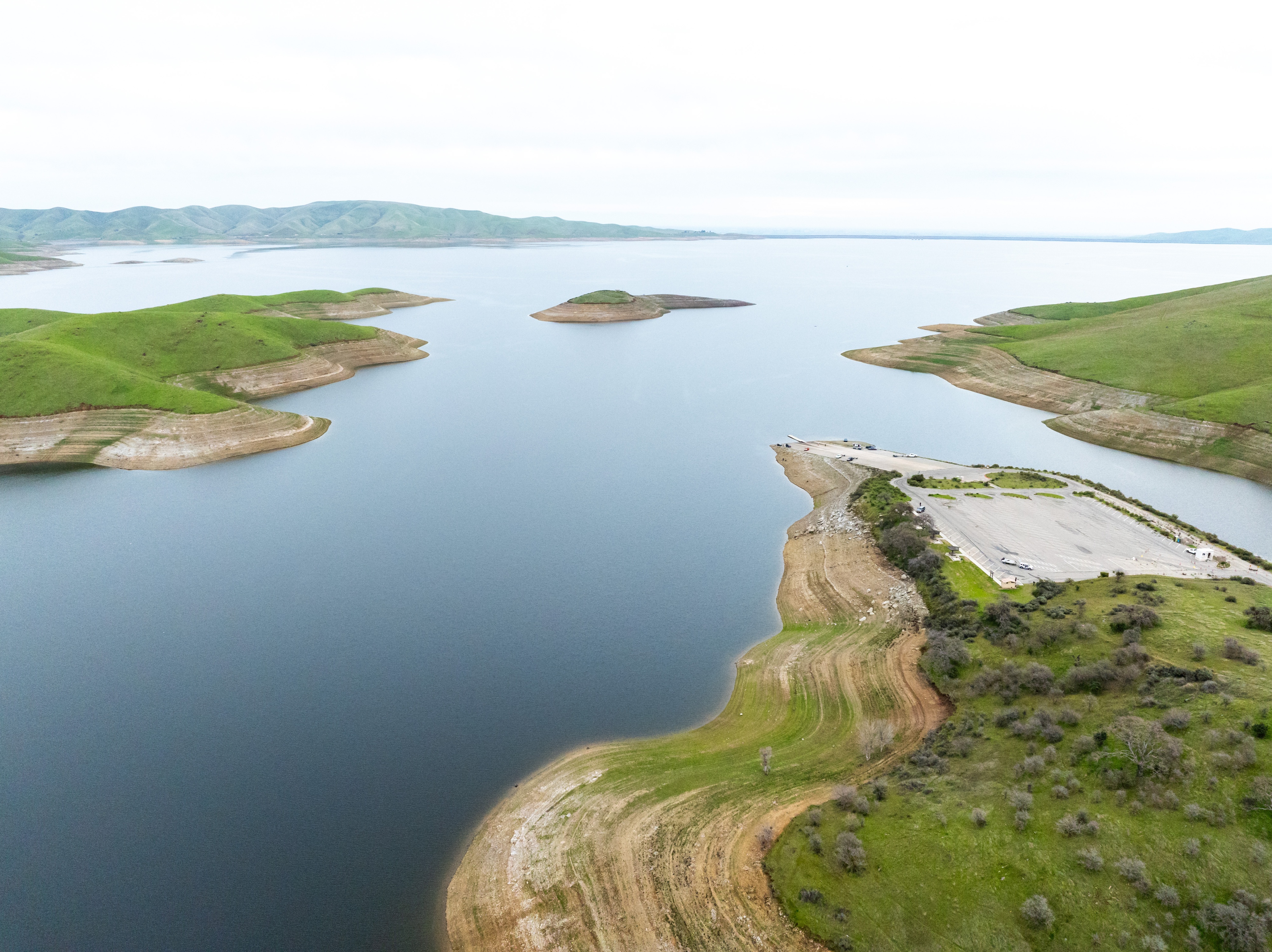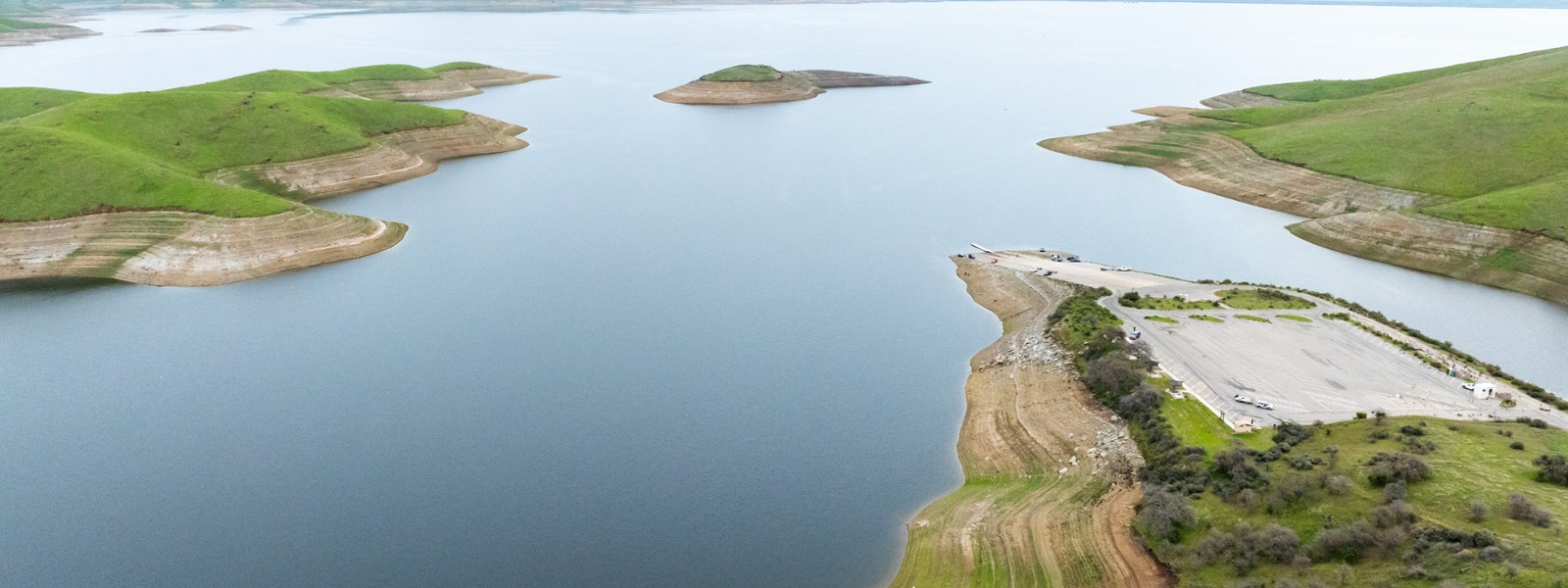Despite wet year, fish protections limit allocations

The San Luis Reservoir, which provides water deliveries to the San Joaquin Valley, was at 65% of capacity when this photo was taken on Feb. 16. By April 1, the reservoir had risen to 73% of capacity.
Photo/California Department of Water Resources.

By Caleb Hampton
State and federal water providers have increased promised allocations after accounting for recent storms that improved snowpack and reservoir levels.
The California Department of Water Resources doubled the amount of water it expects to deliver this year to most contractors that rely on the State Water Project, increasing the allocation for water users south of the Sacramento-San Joaquin River Delta from 15% to 30% of requested supplies. Those north of the delta are expected to receive 50% of their allotment, while Feather River Settlement Contractors will get their full allocation.
The U.S. Bureau of Reclamation, which manages the Central Valley Project, increased allocations for south-of-delta agricultural water users from 15% to 35% of their contracted allotment and from 75% to 100% for those north of the delta. The revised allocations followed a new snow survey measurement released March 1 and a spring runoff forecast released March 8. As of April 1, statewide snowpack was 104% of average for that date. A final water allocation for the year, accounting for springtime precipitation, is expected in May or June.
In their initial allocations, water agencies are “cautious about not overcommitting water supplies that may not materialize,” said Chris Scheuring, senior counsel for the California Farm Bureau, adding that water allocations may still increase.
“We’re optimistic,” he said. “Hopefully, the season finishes out with another blast or two of rain, and we hope everybody is able to get full deliveries in a decent year like this one.”
Agricultural water users in the San Joaquin Valley voiced frustration at receiving roughly a third of their contracted allotment during a year with above-average precipitation, following historic rain and snow events last year that replenished California’s reservoirs.
“This is very disappointing and not because our expectations are unrealistic,” said Allison Febbo, general manager for Westlands Water District, a major water provider that supplies farms in Fresno and Kings counties. “The broad public discussions surrounding water management in California have led us to believe that higher levels of delivery would be possible in better hydrologic years, such as this one.”
Allocations for farmers and other contractors south of the delta were limited by the presence of protected fish species near pumping facilities, which resulted in reduced pumping from the delta into the San Luis Reservoir. The reservoir serves state and federal water systems.
“While the series of storms in Northern California improved the water supply outlook, a number of factors, particularly anticipated regulatory constraints throughout the spring, continue to limit the water supply allocation for south-of-delta agriculture,” said Karl Stock, regional director for the Bureau of Reclamation.
DWR director Karla Nemeth said the state agency was doing its best “to balance water supply needs while protecting native fish species.”
The threatened and endangered fish species found near pumping facilities include delta smelt, winter-run chinook salmon and steelhead trout. Regulations designed to protect those species have made it hard for San Joaquin Valley farmers to anticipate water supplies from year to year, Scheuring said.
“Oftentimes, we find that species-related restrictions hamper the flow of water from north to south,” he said. “It is not so much a supply problem as a regulatory problem and, some would say, an infrastructure problem.”
DWR emphasized the need for the Delta Conveyance Project, which would move water south from the delta through a 45-mile tunnel. The $16 billion project would “make it possible to move more water during high flow events while helping fish species like steelhead trout avoid threats posed by current pumping infrastructure,” the department said.
In December, the water agency released a final environmental impact report, approving the project. The tunnel still needs buy-in from water users that would fund the project, and it faces challenges from opponents trying to block it in court.
Febbo said the inability to move water south through the current system has consequences for crop production and the people who make their living from agriculture.
“Inadequate and unpredictable water supplies have a direct impact on the communities and farms in the San Joaquin Valley and their ability to feed the nation and the world,” she said. Febbo called the most recent allocation “a missed opportunity to celebrate what appears to be good outcomes for fisheries and to also provide water supplies that are essential for the San Joaquin Valley, an area already struggling with economic challenges and rising unemployment.”
Nicole Nicks, general manager at Westside Transplant in Merced County, which supplies tomato transplants to farmers across the state, said last month that growers in the Westlands Water District were hesitating to plant processing tomatoes because of uncertainty around water supplies.
While tomato acreage is largely dictated by the supply needs of canneries, which are contracting less tonnage this year, Nicks said water supplies also play a role.
“It was kind of shocking,” she said last week, that the allocation for farmers south of the delta was not increased more. A larger revision, in line with the state’s water supplies, might have prompted some growers to order more tomato transplants, she said.
“Depending on how things go,” Nicks said, “they could still change the allocation. But by that time, it’s kind of too late.”
Westlands Water District said it conducted an analysis that found steelhead trout and winter-run chinook salmon “are expected to trigger further restrictions on delta pumping into June,” which is after farmers of many crops will have made their cropping decisions for the year.
“The hydrology this year is good,” Scheuring said. “If we have folks that are getting shorted, that’s a problem.”
(Caleb Hampton is an assistant editor of Ag Alert. He may be contacted at champton@cfbf.com.)




